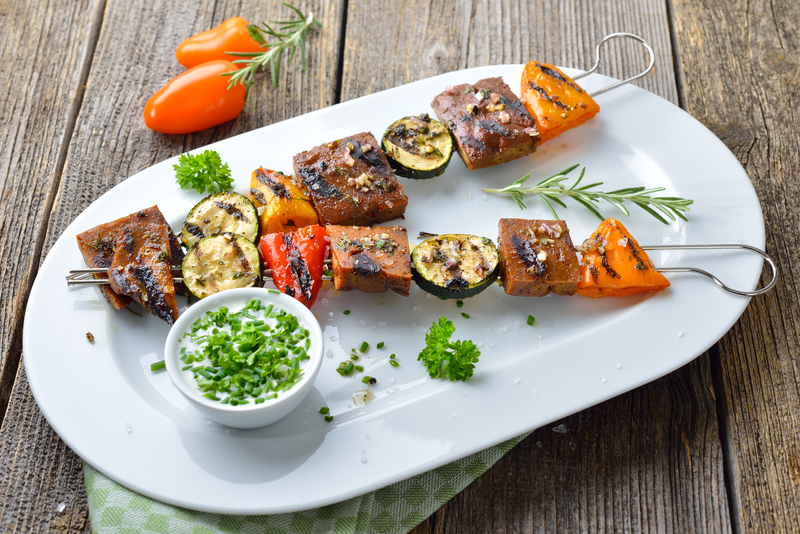What is Seitan & Is This Viral Sensation Good for You?

Many of us are becoming more interested in plant-based diets. Whether that means going vegetarian, vegan, flexitarian, pescatarian, or just giving meatless Mondays a try, many people are looking for good alternative sources of protein. Enter seitan (pronounced SAY-tan). What is seitan?
Well, it’s nothing new. In fact, seitan—also called wheat meat, wheat gluten, mock duck, fu, wheat protein, vital wheat gluten, or simply gluten—has been around for centuries. It’s said to have originated in Asia where Buddhist monks used it to replace meat.
What is Seitan?
Don’t confuse seitan with the flour in bread just because it’s made with wheat. The chewy texture and feel come much closer to meat than dough. And that’s why it’s found in so many commercial vegetarian products from meat-free hotdogs to fakin’-bacon to meat-less ground beef or sausage to Tofurky.
Seitan is made from just the wheat gluten or wheat protein, with the starch removed, to become a very dense, chewy, meat-like product—much more so than other vegan protein options like tofu or tempeh. Thus, once seasoned and cooked, it’s a popular meat substitute for vegetarian or vegan dishes.
A one-ounce serving of seitan provides 104 calories and 21 grams of protein, which is in line with many animal products like chicken or beef. It’s also a healthy source of selenium (16% RDI), iron (8% RDI), phosphorus (7% RDI), and calcium (4% RDI). Because seitan is made from wheat, you may think it’s high in carbs. But, it’s actually quite low with only 4 grams of carbs per serving. And it’s also very low in fat with just .5 grams.
Seitan is high in protein; however, because it lacks lysine, it isn’t considered a complete protein. To get all of the amino acids your body needs, add some lysine-rich foods like beans, quinoa, lentils, pistachios, or pumpkin seeds.
While you can make seitan yourself, it can be a very time and labor-intensive process. It takes work to knead the wheat flour in water to remove the starch, leaving just the sticky strands of protein. While the prep and cook time is only around 50 minutes, the total preparation takes 9 or more hours as it soaks for several hours or overnight to wash away all the starch. (So, if you make it, you may want to make a large batch, so you can freeze extra for future recipes for up to three months.)
Alternatively, you can purchase vital wheat gluten (for example, from Bob’s Red Mill). You’ll still need to mix it well with your hands, but it takes much less time (2 minutes kneading and 15 minutes resting) as you don’t need to rinse away all the starch.
Many folks choose to purchase prepared seitan from the refrigerated or frozen sections at the store. If so, read the label carefully as many prepared seitan products have added flavors and additives that can increase calories, carbs, sodium, and other additives or preservatives. Seitan products may also contain added soy or legume flours.
How to Use Seitan
Once prepared, seitan is especially versatile and easy to cook with. It has a somewhat bland flavor (depending on how it’s prepared) similar to plain white chicken or portobello mushrooms. This neutral flavor means it can take on a rich variety of spices, sauces, and condiments. Some common ways to use seitan are:
- As a replacement for ground beef
- Sliced to use in stir-fries
- Marinated, baked, and sliced
- “Pulled” (like pork) and slathered in sauces like barbeque or barbacoa
- Breaded and baked or fried (air or deep-fried)
- In soups and stews
- Grilled
- Steamed
- Sauteed
- Roasted
Its texture, rather than its taste, is what makes seitan so appealing in such a variety of recipes from a barbecue seitan sandwich to a vegetable stir-fry or curry to vegan hot “wings.”
Pros and Cons of Seitan
Overall, seitan provides plenty of nutrition and is high in protein and some minerals. It’s also low in carbs and fats. It is not, however, a complete protein.
For people who are sensitive or intolerant of gluten—and especially people with wheat allergies or celiac disease—seitan is completely off the menu as it is 100% wheat gluten. Those who suffer from leaky gut may also want to avoid seitan as gluten has been associated with increased intestinal permeability. This can lead to greater inflammation and may trigger food sensitivities or exacerbate an autoimmune issue. (The research here, however, is incomplete.)
If eating wheat leads to gas, bloating, joint pain, or other unpleasant effects, remove wheat products like seitan from the diet completely for at least 30 days to see if you feel better. Tempeh may be a better option as this fermented food can be easier to digest and may also help promote a healthier gut microbiome.
However, for people who are sensitive to soy (soy being one of the top eight food allergens in the world), seitan is a popular vegan option. (Just be careful with store-bought options, which may add soy flour or season with soy sauces for flavor.)
Seitan is a highly versatile and easy-to-use high-protein ingredient (once made) that can stand in in virtually any type of meal. And for former (or current) meat-eaters looking for a meat-like texture, seitan can be so convincing, you may wonder if you’re actually eating meat. (So, it’s a good way to introduce vegan eating to those who are more reluctant to try new foods.)
Making seitan from scratch takes a lot of time and effort, but it’s also fairly simple and cost-effective. And, store-bought versions are ready to go quickly and conveniently. However, because seitan is technically a processed food, many nutritionists recommend using it only in moderation and getting most of your nutrition from whole-food options like vegetables, beans and legumes, nuts and seeds, and fruits. Store-bought seitan can also be high in added sodium.
What is Seitan: A Wrap-Up
If you are looking for ways to decrease meat consumption while getting enough protein, there are many options, including seitan. It’s especially attractive for folks looking for something that looks and feels a lot like meat or who are avoiding soy options like tofu or tempeh. It’s not for everyone, though. Those who have a wheat allergy or intolerance or who may be struggling with gut issues will want to avoid it.
If you do choose to give it a try, you can make your own or just choose the least processed version you can find at your local grocery store. And remember, you don’t have to be vegan or vegetarian to enjoy this popular meat alternative from time to time.





 7 Signs Your Body is Seriously Low on Collagen (not just wrinkles)
7 Signs Your Body is Seriously Low on Collagen (not just wrinkles) Health Expert: "Turmeric Doesn't Work (unless...)"
Health Expert: "Turmeric Doesn't Work (unless...)" 3 Warning Signs Your Probiotic Supplement is a Total Waste
3 Warning Signs Your Probiotic Supplement is a Total Waste

